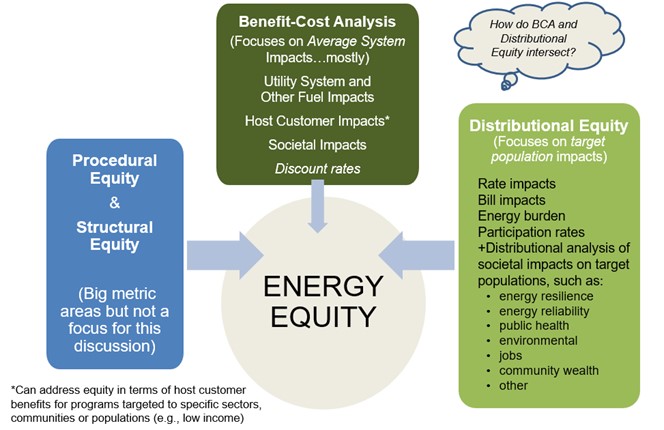Energy Equity and BCA
(Continued from NESP Quarterly February 14, 2022) — We first posed the question “How do we account for energy equity in BCAs?” in our June 2021 newsletter. We’ve since further collaborated with organizations to evolve our conceptual framework for how and where energy equity fits within benefit-cost analysis. Below is a summary of this framework, which is a work in progress. With further input and refinement from key stakeholders, our aim is to develop compendium guidance to the NSPM this year.
“An equitable energy system is one where the economic, health, and social benefits of participation extend to all levels of society, regardless of ability, race, or socioeconomic status. Achieving energy equity requires intentionally designing systems, technology, procedures, and policies that lead to the fair and just distribution of benefits in the energy system.”
PNNL: Review of Energy Equity Metrics – Oct 2021
Affirming equity in all aspects of the energy system is key to building a just and clean energy system and is increasingly being identified as a key policy goal by legislatures around the country. Many PUCs, utilities and stakeholders are making strides in addressing energy equity by developing procedural metrics to ensure participation by target populations (e.g., marginalized communities) in program design, delivery and decision making, and setting goals to increase program participation and reduce energy burden for target populations. These efforts are critical to addressing key aspects of energy equity. However, more work is needed to explicitly measure the distributional impacts of DER programs i.e., will program benefits be distributed equitably across all customers, including target populations?
Benefit-cost analysis is used to measure the utility system, host customer, and societal costs[1] and benefits of a DER program or policy on average across the utility system, typically expressed as monetized impacts or benefit-cost ratios (BCR). BCA can incorporate some aspects of energy equity, primarily in cases where a program is designed, implemented and evaluated for a specific target population (e.g., limited income, an EJ community program, etc.). In these cases, both energy and non-energy benefits to host customers can be assessed, or in some cases alternative BC ratio thresholds can be used (e.g., < 1.0). Additionally, transgenerational equity can be captured by using low discount rates (e.g., 2-3%) to calculate the net present value of the impacts: where a greater value is placed on the impacts of DER investments in the long-term versus the short-term. But these aspects of BCA do not fully address the distribution of benefits and costs to target populations.
To address distributional impacts, we offer the conceptual framework in the figure below, where distributional equity analyses (DEA) are conducted alongside BCAs when evaluating programs and policies. This is in addition to, but separate from, addressing procedural and structural energy equity metrics. DEAs can help determine if program benefits will be distributed equitably to target populations, where metrics can include:
- Rate (¢/kwh) and bill ($/month) impacts;
- Participation rates (% eligible) in programs;
- Energy burden (% of income spent on energy bills)
- Impacts on health & safety, economic development (job-years), reliability (CEMI – Customers Experiencing Multiple Interruptions), resilience (customer outages, restoration time, etc.); and
- Environmental /health and other impacts in specific locations / geographic areas.

NESP is still refining this framework, but we believe it will help provide jurisdictions with a path to explicitly measure and include distributional equity in decision making. Questions and challenges remain regarding the framework’s use, including:
- Is distributional equity analysis a part of a broader BCA, or is it a distinct analysis?
- How should distributional equity analysis results be presented? How should stakeholders use distributional equity analysis results in decision making?
- What customer data must utilities collect in order to conduct a distributional equity analysis, and what challenges are there to collecting this data?
As NESP drafts guidance on this topic, we will continue to collaborate with and seek input from our peers in this space, including key work from the following organizations/companies:
- ACEEE – Leading with Equity Initiative
- Illume Advising – Energy Equity Playbook
- PNNL – Review of Energy Equity Metrics
- NYU Institute for Policy Integrity
- Advancing Equity in Utility Regulation
- RAP – Smart Rate Design for DERs
- VEIC – The State of Equity Measurement
- Energy Equity Project – EEP Overview
- Equity in Clean Energy Economy (ECEE) Collaborative
In the meantime, we welcome your thoughts and feedback on this conceptual framework and invite your comments at nspm@nationalenergyscreeningproject.org
See the entire February 2022 NESP Quarterly.
[1] The extent to which a jurisdiction accounts for host customer and/or societal impacts should depend on the applicable policies in the jurisdiction – consistent with NSPM Principle #2 – and applies to accounting for energy equity in regulatory decisions regarding resource investments.

